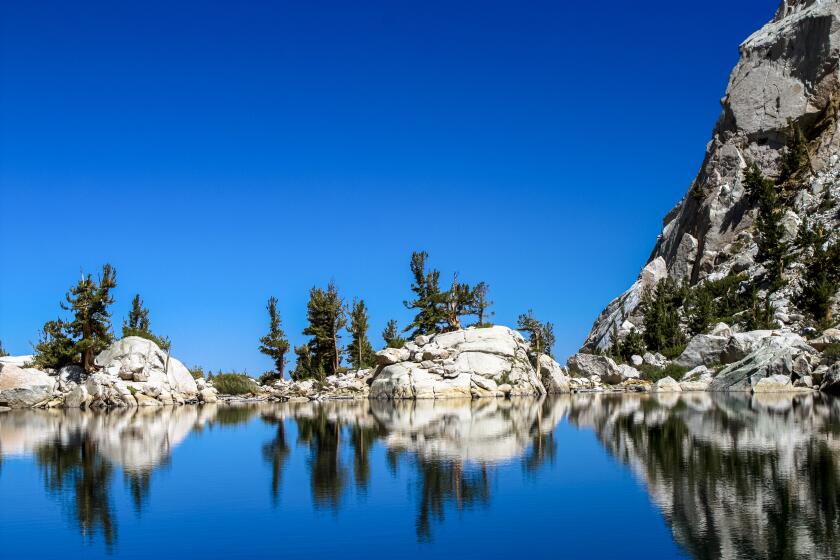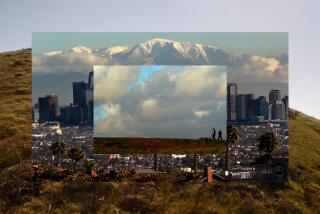It’s a glorious time to hike the High Sierra, now a paradise of wildflowers and snow
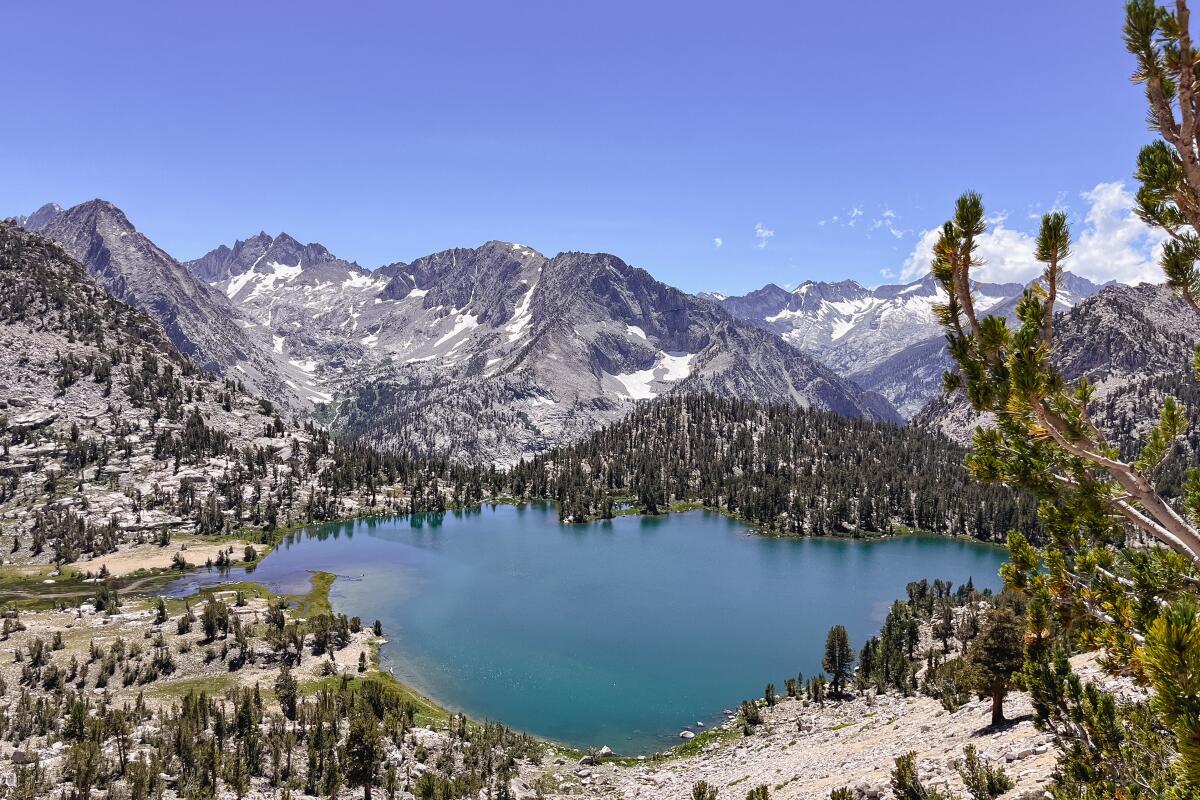
- Share via
“Have you ever heard of the cowboy straddle?” my partner, Emanuel, asked.
Without waiting for a reply, he hoisted himself onto a log suspended above a rushing stream and began using branches on either side — as if clutching the horns of a steer — to leapfrog across.
It marked one of many stream crossings we’d make over our recent four-day backpacking trip through the soaring peaks of the High Sierra. Water gushed, swished or sat stoically silent. Sometimes it was frozen. Snow patches clung to craggy rock faces — a rare sight in the last gasps of summer.
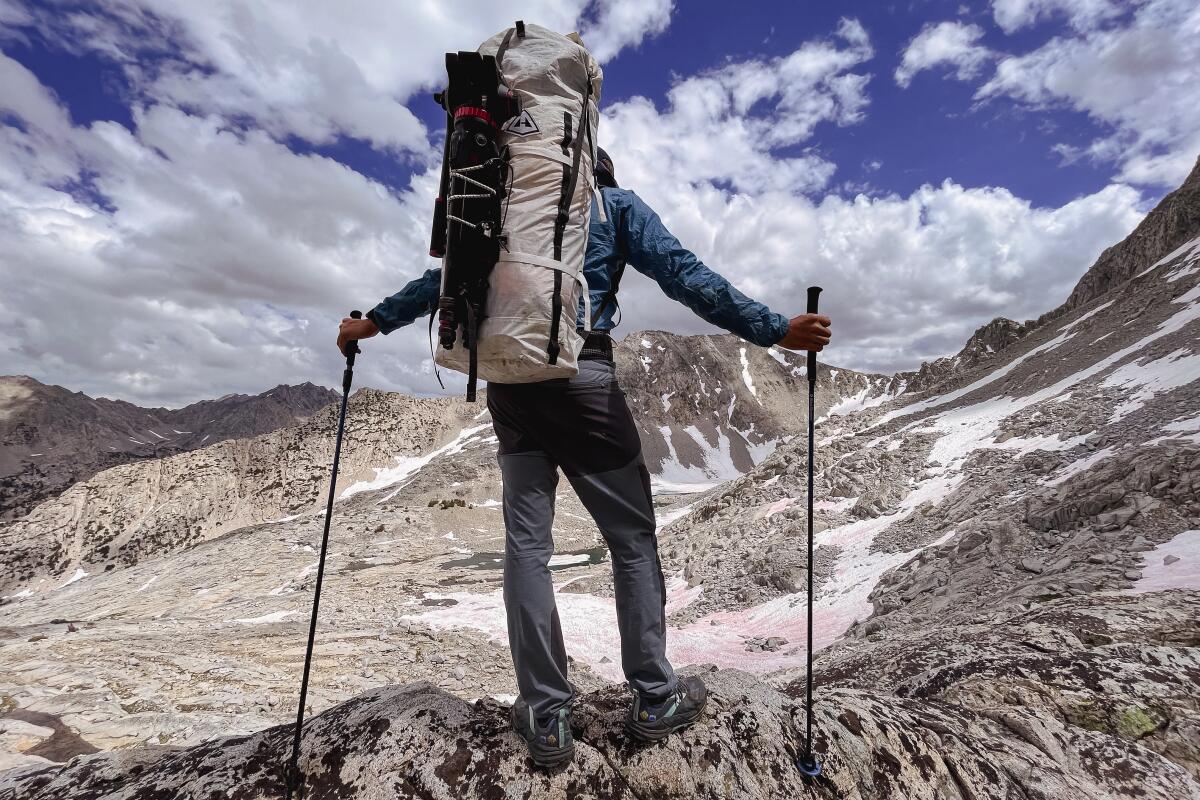
The effect was, at times, hazardous. While on a vague trail through Gardiner Basin, a rarely explored area, we encountered sheets of snow that descended into an icy lake, curled up at the ends like a demonic slide. I slipped microspikes over my trail runners and focused on taking one careful step at a time.
Wet socks notwithstanding, glory abounded. Above 10,000 feet, we were closer to sky and all its colorful whims. Alpine lakes glittered at every turn, while haunting moonscapes greeted us beyond the treeline.
Record snowfall pummeled the mountainous region rising from eastern California last winter and spring, creating perilous conditions into July. The UC Berkeley Central Sierra Snow Lab saw nearly 63 feet of snow by mid-March. Statewide, the snowpack reached 232% of average for April 1. Passage was long impractical for the average recreator.
But much of the snowpack has finally melted, making popular trails — including portions of the Pacific Crest and John Muir — more accessible than they’ve likely been all year. Recently surging watercourses have mellowed to tenable levels. Fears of catastrophic flooding of the Owens Valley below have evaporated. And all the snowmelt has brilliantly greened what’s often a dry, brown tinder box by this time of year. Extreme fire conditions prompted closures in the area just two years ago. Instead of oppressive smoke, visitors this year were treated to abundant wildflowers.

With the fierce winter delaying backpacking season, September might be the best time to hike among the lofty peaks. It’s at least likely to be the driest time.
“It’s probably the perfect month this year — and maybe into the first half of October,” said Doug Robinson, a legendary Sierra climber, skier and guide. He’s already recommended it to several friends, including one planning to start the John Muir Trail at the end of the month.
It’s important to note that even in the best conditions, hiking in the High Sierra is not easy. Planning and outdoors experience is essential. Backpacking in the early days of fall — particularly after months of wild weather — presents unique challenges. Here’s what to know if you want to make the journey.
What makes the High Sierra so special
About three hours north of Los Angeles, up scenic Highway 395, Mt. Whitney — the highest peak in the contiguous U.S. — looms 14,505 feet above the quaint town of Lone Pine. It’s impressive from Down There, but distance gives it a two-dimensional quality. Heading into the mountains opens up an expansive, mysterious world — of sparkling lakes and imposing granite cliffs.
With the right conditioning plan, trekking to tallest mountain peak in the Lower 48 is more attainable than you think.
Trekking through dramatic elevation shifts means equally dramatic shifts in scenery. Lower down, we walked through lush valleys surrounded by jagged mountainscapes. Breathtaking 60 Lakes Basin could rival Disney’s take on the Swiss Alps. At Gardiner Pass, we descended from a fragrant pine forest into steep rock piles smeared with snow.
For the record:
7:00 p.m. Sept. 11, 2023A previous version of this story stated the the High Sierra runs north from Lake Tahoe to the Golden Trout Wilderness. It runs south from Lake Tahoe.
The High Sierra — straightforwardly named for its lofty elevation — runs south from Lake Tahoe to the Golden Trout Wilderness, south of Sequoia National Park. It encompasses parts of Yosemite, Kings Canyon and Sequoia National Parks and several U.S. Forest Service areas, including the Inyo National Forest along the east side. Rugged souls like Ansel Adams, Norman Clyde and John Muir swooned over the expansive range.
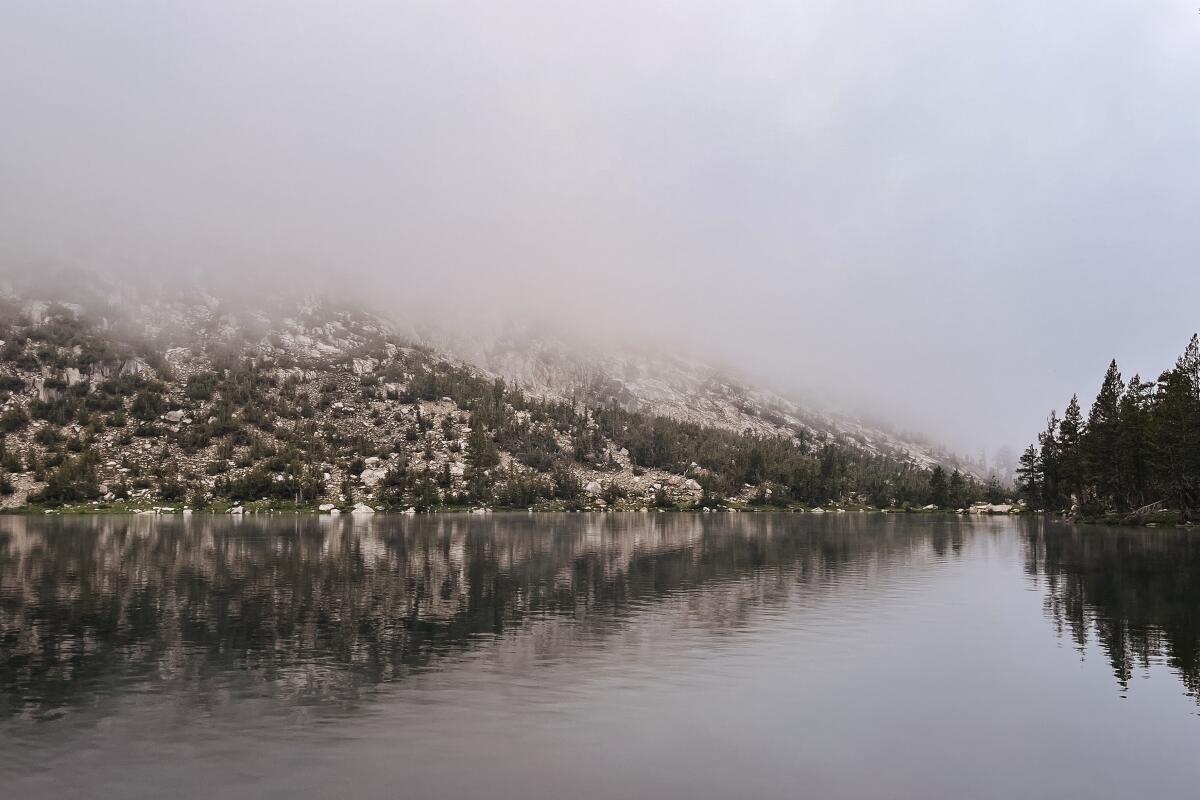
“It’s only the finest mountain range in the world,” said Robinson, who describes himself as a “Sierra chauvinist.”
“The landforms are just beautiful, and they invite you to hike over them,” he said.
Despite this year’s unusual weather, the region is beloved for its generally fantastic weather.
“Bluebird skies day after day after day,” as Andrew Skurka, a professional backpacker and guide, described it. During a three-week trip over the summer, he didn’t set up his shelter once.
The weather forecast for the next few months
Warmth, like ease, is a relative concept in the High Sierra.
Meteorological fall began Sept. 1 and temperatures will continue to trend down. Even warm, sunny days can give way to frigid nights, which are growing longer. The temperature decreases as elevation increases.
By the last week of September, expect overnight temperatures at or below freezing. That’s already the case in higher elevations.
Daytime temperatures in the 60s in Yosemite’s high country can slip into the 30s at night. By October, those average high and lows drop about 10 degrees. Snow fell in early September above 13,000 feet and more storms are around the corner.
While it might sound brisk to the average Angeleno, many adventure seekers see it as prime hiking weather. Physical exertion — say, trekking 10 miles up steep terrain with a heavy backpack — can make a chilly day feel fiery.
“It’s a really nice kind of break between some of the heat that we get in the summer and before the snow flies,” said Scott Gediman, spokesperson for Yosemite National Park.
Still, it’s critical to have the right clothing. Gediman said it’s ideal to bring layers for a variety of conditions.
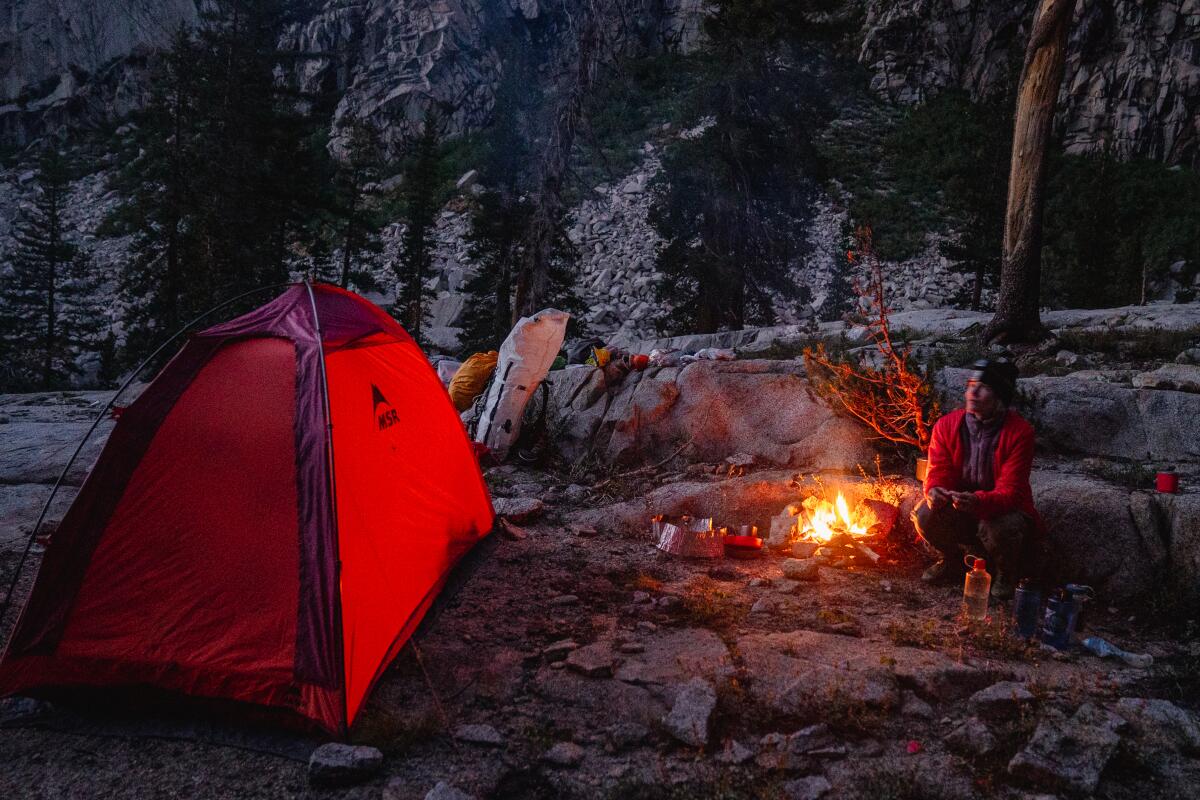
Forecasts for towns near the mountains, like Bishop and Lone Pine, won’t provide insight into what’s happening above 10,000 feet.
Skurka recommends using Weather.gov, which allows users to get more specific forecasts by clicking on a point on a map.
Besides air temperature, it’s key to look at precipitation, wind and other factors.
Outdoors wonks often think in terms of “weather windows,” or streaks in the forecast that look most advantageous for the adventure they’re cooking up.
An El Niño climate pattern arrived in June, but its predicted impact depends on location.
Typically, a moderate or strong El Niño signals wetter-than-normal weather in Southern California, and the Southland’s San Bernardino Mountains could see more rain.
Central and Northern California is more of a toss up in terms of precipitation, said Andrew Schwartz, lead scientist and manager at the Central Sierra Snow Lab.
Temperature forecasts are clearer: “Warm is going to be the trend that we’re looking at,” he said.
How to get permits
Backpacking in the High Sierra requires a permit. Day hiking typically doesn’t, except when visiting Mt. Whitney. Check out Recreation.gov to see what’s available and book your trip.
During quota season, which coincides with peak recreation months, the number of people starting at a given trail each day is capped.
Permits for iconic hikes, such as the JMT and High Sierra Trail, are competitive and sell out rapidly. Mt. Whitney is one of the hardest to snag. Many other trailheads are also difficult to secure, but there are lower-demand areas that can be booked with less advance planning.
Nabbing permits is a wilderness skill all in its own. Different areas have different permit processes in place, so do your research.
A simple hack is to identify your trip dates and then check Recreation.gov frequently. Some permits are released throughout the year and others periodically free up as people cancel trips.
Permits with entry points on the east side of the range can be picked up in person from the Eastern Sierra Visitor Center in Lone Pine. My Sierra-loving partner, Emanuel Röhss, recommends that people who are new to exploring the area take the opportunity to discuss their plans with rangers, who can provide information about conditions and restrictions.
What to bring on your trip
A complete gear list is beyond the scope of this abridged guide. What you decide to bring will depend on the length of your trip, experience and level and tolerance for carrying weight.
However, I asked a few Sierra sages if they had any recommendations in light of the lingering traces of winter mayhem.
Given the return to relatively normal conditions, Skurka said a typical kit should suffice with the addition of microspikes. The traction devices are fitted over shoes and can be used to traverse moderate snow.
He also recommends bringing two pairs of hiking socks. With so much water flowing in the mountains, wet feet are hard to avoid. If one pair gets wet, he taps the other.
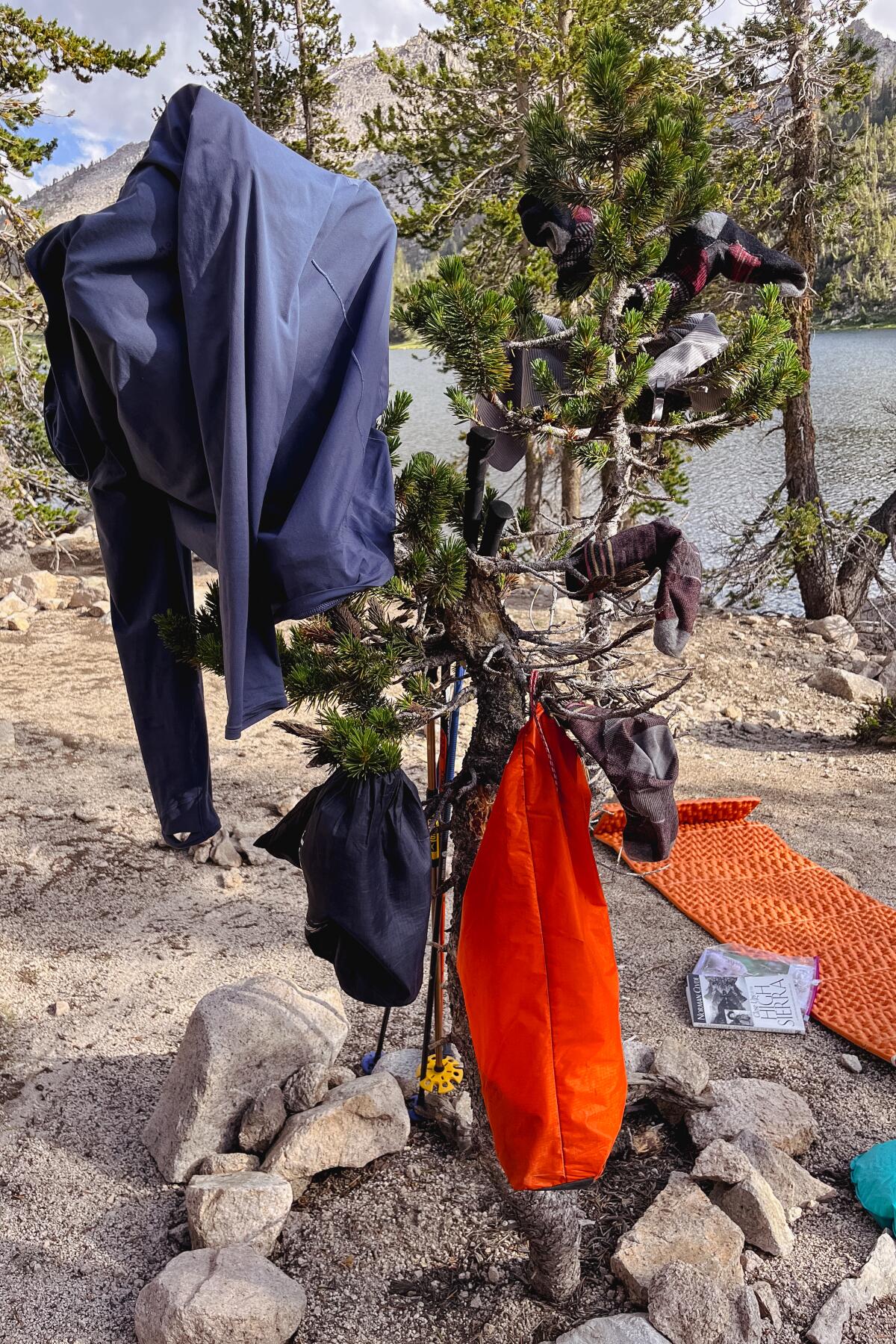
Robinson’s tip was also foot-related: Hikers should consider bringing a stout pair of waterproof boots and gaiters.
“Into October it’s been known to snow two feet. Watch your back; keep considering your exit from the Sierra,” he said. “From the JMT that can mean up 3,000 feet over a pass. You can probably make it out in tenny-runners without getting frostbite, but not without some misery — the epic factor.”
Stouter shoes can also help prevent spraining an ankle, he said.
Also, do not underestimate the bugs. Many people, myself included, who ventured into the Sierra backcountry in recent weeks were met with a blood-sucking scourge: mosquitoes. Sometimes nightmarish swarms of them.
The record snowfall followed by a delayed melt pushed back the typical mosquito boom.
On our third day, camped near a waterfall, I spat the winged vermin out of my mouth while trying to eat oatmeal. They bit right through my sun hoodie and were unphased by Citronella spray.
There are ways to avoid similar pain:
- Bug spray containing DEET
- Head nets
- Permethrin-treated clothing
Thankfully, as temperatures cool off, mosquitoes will too.
Above all, it’s important to be flexible
All the planning in the world and heaps of top-of-the-line gear can’t guarantee things will go according to plan.
A sign of experience is knowing your limits — and knowing when to turn around.
“Your itinerary is not set in stone,” Robinson stressed. “You’re in the wilderness and your safety depends on making good judgments and sticking to them.”
It’s helpful to have a Plan B waiting in the wings in case of inclement weather or another unexpected bummer, Skurka said.
When Fernando Garcia encountered a bridge along the John Muir Trail last month that was being demolished after sustaining severe snow damage, he considered taking an alternate route. But the 54-year-old Los Angeles resident began having trouble with his phone, which he used to find water.
At that point, he made the decision to pull out and make a plan to return the following year. It hasn’t dimmed his sense of triumph.
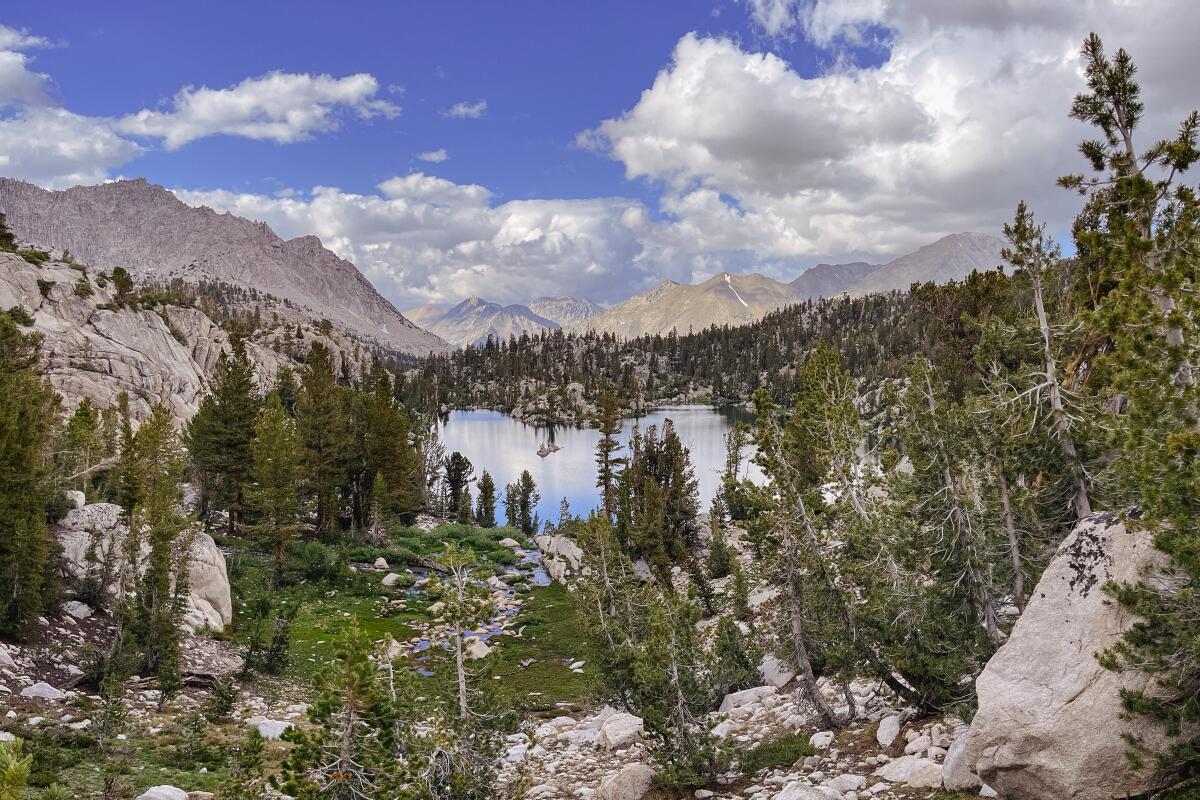
Hiking the famed trail that runs between the Yosemite Valley and Mt. Whitney became Garcia’s beacon of hope in 2020 when he was going into surgery for a brain tumor. He began telling hospital workers he needed to make it through so he could fulfill the dream.
Last year, Garcia took a celebratory lap of 138 miles on the route. In August, he came back to clock more miles.
“It’s definitely emotionally overwhelming at times, in a good sense,” he said. “ The gratitude that I felt being out there ... I probably looked like a crazy person smiling as I was going along.”
More to Read
Sign up for The Wild
We’ll help you find the best places to hike, bike and run, as well as the perfect silent spots for meditation and yoga.
You may occasionally receive promotional content from the Los Angeles Times.

